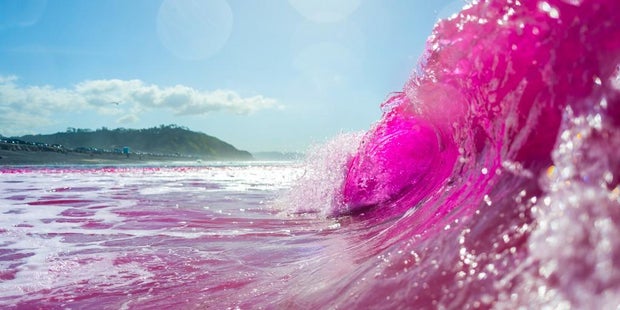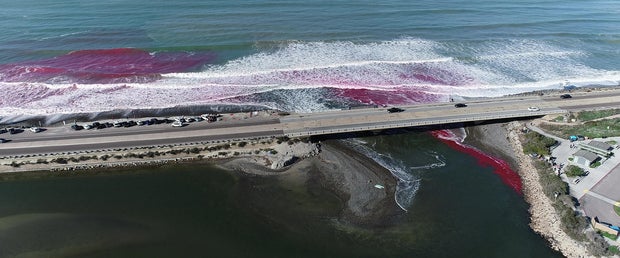The usual blue waters of the Pacific Ocean off the coast of San Diego are looking quite different — at least for a while. Bright fuchsia-colored waves were seen crashing along the shore in the past week, and researchers have revealed just what's causing the sudden and dramatic color change.
It's science.
Scripps Institution of Oceanography is actually responsible for the temporary color change at Torrey Pines State Beach. Researchers are conducting a study, called Plumes in Nearshore Conditions, or PiNC, to learn more about how freshwater interacts with salt water near shore.
By releasing a non-toxic pink dye in the nearby Los Peñasquitos Lagoon coastal estuary, researchers say they are able to monitor what happens to that water when "small-scale plumes" end up in the surf zone along the beach, where the waves break.
This research, Scripps said, will "provide a first-ever view" of how freshwater mixes with the more dense ocean water within waves. That information, they said, is crucial for understanding how sediments, pollutants, larvae and other materials disperse throughout shorelines. The pink plume in this study will be monitored with various instruments, from land, sea and air.
The dye being used poses "no threat to humans, wildlife or the environment," Scripps said, although civilians have been urged to not swim in the area due to the ongoing research.
Scripps coastal oceanographer and study leader Sarah Giddings called the research a "really unique experiment," as many previous studies on this subject matter have focused on large amounts of freshwater going into the ocean. They chose Los Peñasquitos Lagoon because it's a "prime example" of small plumes going into surf zones, she said in a news release.
"We're bringing together a lot of different people with different expertise, such that I think it's going to have some really great results and impacts," she said. "We will combine results from this experiment within older field study and computer models that will allow us to make progress on understanding how these plumes spread."
Giddings' research takes a deep dive into how estuaries and the coastal ocean influence each other. Estuaries, NOAA explains, are "delicate ecosystems" that contain freshwater drained from land as well as salty seawater. They are also "one of the most threatened ecosystems on Earth," NOAA says, as human activities have negatively impacted their overall health. Because these bodies of water filter out sediments and pollutants from water before flowing into the ocean, they are a vital component of health for marine life.
According to the research project's website, Giddings and her team hypothesize that four things could potentially be happening to the freshwater as it interacts with the ocean waves: It gets trapped in the surf zone and/or escapes as a freshwater plume; it stays within a certain parameter of the coastline; it escapes the surf zone through rip currents; or finally, that waves mix the freshwater with the ocean water next to the shore.
Giddings' team is doing three dye releases, the first of which was on Jan. 20. Another release is planned sometime before the end of the month and another in early February. During a release, researchers put 15 gallons of the dye into the estuary as the tide level is falling. The researchers say the bright pink coloration is then visible to the naked eye for several hours, and small traces are able to be detected for about 24 hours.
The first experiment saw "much success," researchers said on their website. The dye revealed that the initial plume was trapped in the surf zone but that it was eventually carried south with some of the plume getting ejected from the surf zone.
"some" - Google News
January 27, 2023 at 12:30AM
https://ift.tt/4dpTiEZ
Some of San Diego's waves turned bright pink. Here's why. - CBS News
"some" - Google News
https://ift.tt/RWk8rqQ
Shoes Man Tutorial
Pos News Update
Meme Update
Korean Entertainment News
Japan News Update
Bagikan Berita Ini


















0 Response to "Some of San Diego's waves turned bright pink. Here's why. - CBS News"
Post a Comment